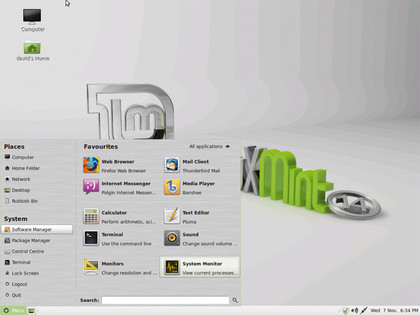How Mint became one of the most popular Linux distros
The vibrant Linux community knows what it wants, and even the developers of the more popular distributions of the time, Canonical and Novell OpenSUSE for instance, were settled in their ways, and discouraged the adoption of improvements based on feedback from the user base. This is what formed the rock-solid foundation that Linux Mint was built on.
Its ability to listen, learn and develop around the needs and suggestions of the users created an experience that left a positive mark on those who installed Mint. In fact, of the many who parted ways with their previous operating systems at that time, many have remained faithful to Linux Mint, and even now sing the praises of what can only be described as 'their' operating system. It's one thing to encourage a user to install and use a product, but something else entirely to have that user present six years later, still enjoying it.
Mint: the new Ubuntu?

Common origins but different paths
Clem knew what he was doing when he chose Ubuntu as the basis for Mint. He says:
"Ubuntu was chosen for its package base. It was excellent as a distribution, easy to build upon, it had a frozen cycle… there was no question there, it simply was the best base available, so if I was to base my efforts on an existing package base, it had to be Ubuntu. Other distributions were faster, snappier, or allowed multiple versions of the same software to be installed, but from an overall point of view, Ubuntu was by far the best distribution."
In the years that followed, however, Ubuntu and Mint's paths started to diverge. Ubuntu, for all of its 'Linux for Human Beings' rhetoric, decided to opt for a radical-at-the-time desktop environment. Of course, we are referring to the much maligned Unity; it's remarkable how much animosity can be generated toward the visual interpretation of a few lines of code.
In a community that tolerates almost any eccentricity, Unity was hated as much as any release by the likes of Microsoft. The other offerings from and related to Ubuntu: Kubuntu, Xubuntu, and so on, have kept their theme, and as a result have managed to retain their fan base, but it was the core Ubuntu direction, and its alleged flagrant disregard for heeding the views and opinions of those using the software that forced a number of stalwarts to jump ship.
Sign up for breaking news, reviews, opinion, top tech deals, and more.
Many of the refugees of Ubuntu found solace in Linux Mint, which at the time was still operating with a classic Gnome 2 desktop environment; but the world was changing, and the Gnome development team was taking things in one direction, while Ubuntu was taking another.
Mint, finding itself between a rock and hard place, was loath to adopt either the true form of the newly-released Gnome 3, an environment that caused as much controversy as Unity had, or the Ubuntu-implemented Unity. Instead, it employed an eclectic mix of desktops for the user to choose between during installation.
"Many people switched from Ubuntu to Linux Mint in the last two years. According to the feedback we gathered, the main reasons were related to desktop environments," says Clem. "Canonical is a great company, they have talented developers, strong leadership and a clear vision of where they want to go. I'm sure they studied the different markets, and their plan to switch audience certainly makes sense. Do we want to follow them towards touch-interfaces, cloud computing and mobile environments? No. Does it makes sense for them to go there? Probably."
Shared roots
Looking at the previous releases of Mint - from Linux Mint 12: Lisa, based on Ubuntu Oneiric; to Mint number 13: Maya, based on the Precise Pangolin, we see a Linux distribution that offers the advanced and casual user alike an experience that retains the classic look and feel of the desktop, without the commercialisation or look-alike branding that has become the norm.